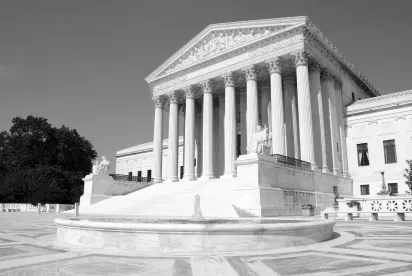The day after the Gallup organization reported that public confidence in the Supreme Court has reached new lows, the Court has added what, to many, will be more fuel to that fire. The long-awaited, hotly contested, and divisive opinion in Dobbs v. Jackson Women’s Health Organization has officially come down and, given reactions to the premature release of a draft of Justice Alito’s majority opinion, the public’s expectations on both sides of the abortion debate have been realized.
A nutshell is far too small a space to contain a thorough summary of Dobbs and its ramifications. However, the basics are as follows.
The provision at issue was Mississippi’s Gestational Age Act, which provides that “[e]xcept in a medical emergency or in the case of a severe fetal abnormality, a person shall not intentionally or knowingly perform . . . or induce an abortion of an unborn human being if the probable gestational age of the unborn human being has been determined to be greater than fifteen (15) weeks.”
The essence of the majority opinion is that the Constitution does not prohibit the citizens of each state from regulating or prohibiting abortion. Since Roe v. Wade and Planned Parenthood v. Casey arrogated that authority, the Court overrules those cases and consigns that authority to the people and their elected representatives.
In upholding the Mississippi statute itself, the majority recognizes that abortion presents a “profound moral question” as to which states could reach differing conclusions, but that the Mississippi Legislature had reasons to think that it would serve legitimate state interests, as supported by specific findings and the state’s asserted interest in “protecting the life of the unborn,” that provide a rational basis for the Gestational Age Act. Thus, it follows that respondents’ constitutional challenge must fail.
The vote to uphold the Mississippi law was 6–3, along strict philosophical lines, with the Chief Justice agreeing with Justice Alito’s majority opinion, which was joined by Justices Thomas, Gorsuch, Kavanaugh, and Barrett. Several concurrences amplify certain individual views.
The count as to overturning Roe v. Wade and Planned Parenthood v. Casey was one fewer, with Chief Justice Roberts writing a separate opinion stating that he would not have overturned Roe v. Wade. To most observers, this shows nothing more than that the Chief Justice is not in control of the Court and won’t be unless death or resignation and a Democratic President and Congress eventually intervene to provide successor Justices.
As was easily predictable, Justices Breyer, Kagan, and Sotomayor filed a joint dissent. The dissenters stress the adverse effects that today’s decision might have on women who can’t afford to travel to states where abortion will remain lawful and upon the force of stare decisis, which will become a bellwether in future litigations where the viability of asserted rights, e.g., those concerning sexual and gender issues, might be re-contested. The dissenters also accept the view that abortion decisions are a form of liberty protected by the Due Process Clause of the Fourteenth Amendment.
The rejection of stare decisis in this case will, whatever its outcome might be, open the discussion in future cases as to what forms of “liberty” are protected by the Due Process Clause, and the extent to which such “rights” are “deeply rooted in this Nation’s history and tradition” or are “implicit in the concept of ordered liberty.”
The opinions are masterful dueling expositions on stare decisis, which will be irrelevant to the public debate about both sides’ political opinions and expectations as to the Court and how the Justices behave or should behave.
Within a short time, as many as 26 states, most of which have so-called “trigger” laws, will ban all or most abortion procedures, some at as little as five weeks of pregnancy. The laws of several coastal states, on the other hand, may well be strengthened as those states become abortion havens. Some major companies already have announced that they will reimburse their employees who go to those states for reproductive services for their travel and treatment expenses. I note here that my law firm (as well, I’m sure, as others) has a webpage that describes the issues that employers and reproductive service and other health care providers now face.
The day’s other opinion, that in Becerra v. Empire Health Foundation, is likely to be lost in the fog of war, at least in the short run. But, looking ahead, the case is likely to be of great importance, not only in the complex area of health care reimbursement, but in administrative law reviews of agency action more generally as well.
The case concerned a Department of Health and Human Services (HHS) regulation that sets forth the Medicare Part A “disproportionate share hospital” (DSH) adjustment that provides higher-than-usual rates to hospitals that serve a higher-than-usual percentage of low-income patients. To calculate the DSH adjustment, HHS adds together a Medicare fraction—which represents the proportion of a hospital’s Medicare patients who have low incomes—and a Medicaid fraction—which represents the proportion of a hospital’s total patients who are not entitled to Medicare and have low incomes. That addition produces a “disproportionate patient percentage” which determines whether a hospital will receive a DSH adjustment, and how large it will be if it does. The Court upheld the HHS conclusion that, if a patient meets the basic statutory criteria for Medicare (i.e., is over 65 or disabled), then the patient counts in the denominator and, if poor, in the numerator of the Medicare fraction.
Two sentences into reading the synopsis of the opinion, this writer easily and correctly predicted that the majority opinion would be written by Justice Kagan. Less predictable is the fact that she was joined by Justices Thomas and Barrett, as well as Justices Breyer and Sotomayor, to make a 5–4 majority. That majority held that the HHS regulation applicable to the calculation of the Medicare fraction, when referring to individuals “entitled to [Medicare Part A] benefits,” meant all those qualifying for the program, regardless of whether they receive Medicare payments for part or all of a hospital stay, and that the HHS regulation is consistent with the text, context, and structure of the governing statutory provisions.
The majority rejects the argument of the four dissenters that HHS, which had changed its position on the calculation over the course of years, had done so merely to effect cost savings. Justice Kagan noted the fact that HHS instead had made its change to conform with legal opinions that had been rendered by various courts of appeals.
What is consequential, besides the fact that the result is one vigorously sought by hospitals, is that the Court’s discussion had nothing to do with whether the agency deserved deference per Chevron U.S.A. v. NRDC, 467 U.S. 837 (1984). Thus, while many have suggested that the Court is prepared to overrule Chevron, the debate in today’s case mimics what the Court has been doing recently, which is simply to decide whether an agency’s action is or is not consistent with the text of a statute, even, as in this case, an extremely complex one.
Whew! Only two cases, but cases of great significance. Still more to come before the Court breaks for the Summer.




 />i
/>i

